ThreadLocal 源码学习
ThreadLocal的作用是提供线程内的局部变量,不同的线程之间不会互相干扰,这种变量在线程的生命周期内起作用,减少通一个线程内多个函数或组件之间一些公共变量传递的复杂度。
总结下来就是:
- 线程并发:在多线程并发的场景下
- 传递数据:我们可以通过ThreadLocal在同一线程,不同组件中传递公共变量
- 线程隔离:每个线程的变量都是独立的,不会互相影响
基本使用
在可能有并发访问的对象中设置ThreadLocal变量,然后通过ThreadLocal的set和get方法进行针对某一个线程的变量进行修改和访问。
并发问题出现:
package threadlocaltest;
public class Content {
String content;
public void setContent(String s) {
this.content = s;
}
public String getContent() {
return content;
}
public static void main(String[] args) {
Content c1 = new Content();
for(int i = 0; i < 6; i++) {
Thread t = new Thread(new Runnable() {
@Override
public void run() {
c1.setContent(Thread.currentThread().getName() + "的内容");
System.out.println("------------------------------");
System.out.println(Thread.currentThread().getName() + " ----> " + c1.getContent());
}
});
t.setName("Thread " + i);
t.start();
}
}
}
output
Thread 0 —-> Thread 3的内容
Thread 4 —-> Thread 4的内容
Thread 3 —-> Thread 5的内容
Thread 2 —-> Thread 5的内容
Thread 1 —-> Thread 5的内容
Thread 5 —-> Thread 5的内容
通过加入ThreadLocal变量,代码可以改写为
package threadlocaltest;
public class Content {
ThreadLocal<String> localVal = new ThreadLocal<>();
String content;
public void setContent(String s) {
localVal.set(s);
}
public String getContent() {
return localVal.get();
}
public static void main(String[] args) {
Content c1 = new Content();
for(int i = 0; i < 6; i++) {
Thread t = new Thread(new Runnable() {
@Override
public void run() {
c1.setContent(Thread.currentThread().getName() + "的内容");
// System.out.println("------------------------------");
System.out.println(Thread.currentThread().getName() + " ----> " + c1.getContent());
}
});
t.setName("Thread " + i);
t.start();
}
}
}
output
Thread 0 —-> Thread 0的内容 Thread 1 —-> Thread 1的内容 Thread 2 —-> Thread 2的内容 Thread 5 —-> Thread 5的内容 Thread 3 —-> Thread 3的内容 Thread 4 —-> Thread 4的内容
ThreadLocal vs Synchronized
| synchronized | ThreadLocal | |
|---|---|---|
| 原理 | 同步机制采用“以时间换空间“的方式,只提供了一份变量,让不同的线程排队访问 | ThreadLocal采用”以空间换时间“的方式,为每一个线程都提供了一份变量的副本,从而实现同时访问而相不干扰 |
| 侧重点 | 多个线程之间访问资源的同步 | 多线程中让每个线程之间的数据互相隔离 |
ThreadLocal有两个突出的有事:
- 传递数据:保存每个线程绑定的数据,在需要的地方可以直接获取,避免参数直接传递带来的代码耦合问题
- 线程隔离:各线程之间的数据相互隔离却又具备并发性,避免同步方法带来的性能损失。
ThreadLcoal内部结构
在JDK8中ThreadLocal的设计是:每个Thread都维护一个ThreadLocalMap,这个map的key是ThreadLocal实例本身,value才是真正要存储的值Object。
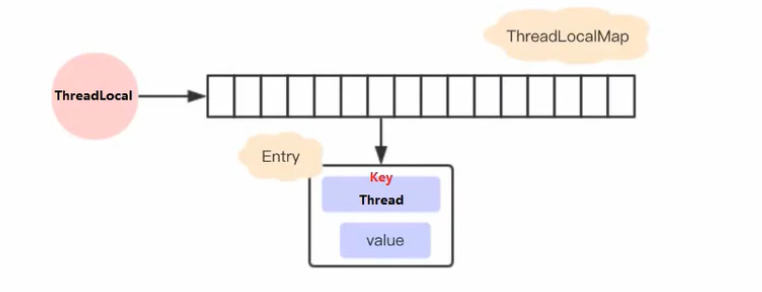
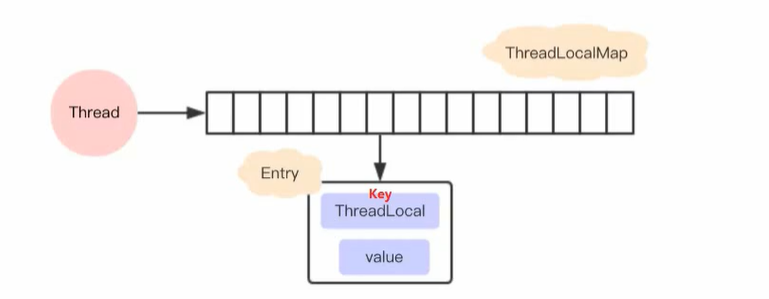
以上是JDK8和之前版本设计的区别,JDK8的具体过程如下:
- 每个thread内部都有一个map
- map里面存储threadlocal对象(key)和线程变量副本(value)
- Thread内部的map是由ThreadLocal维护的,由ThreadLocal负责向map获取和设置线程的变量值
- 对于不同的线程,每次获取副本值时,别的线程并不能获取当前线程的副本值,形成了副本的隔离,互不干扰。
这样设计的好处是:
- 每个Map存储的Entry数量变少,因为ThreadLocal的数量是远远小于线程数量的
- 当Thread销毁的时候,ThreadLocalMap也会随之销毁,减少内存使用。
ThreadLocal源码分析
set方法
/**
* Sets the current thread's copy of this thread-local variable
* to the specified value. Most subclasses will have no need to
* override this method, relying solely on the {@link #initialValue}
* method to set the values of thread-locals.
*
* @param value the value to be stored in the current thread's copy of
* this thread-local.
*/
public void set(T value) {
Thread t = Thread.currentThread();
ThreadLocalMap map = getMap(t);
if (map != null)
map.set(this, value);
else
createMap(t, value);
}
void createMap(Thread t, T firstValue) {
t.threadLocals = new ThreadLocalMap(this, firstValue);
}
流程如下:
- 首先获取当前线程,并故居当前线程获取一个Map
- 如果获取的map不为空,则将参数设置到Map中(当前ThreadLocal的引用作为key)
- 如果Map为空,则给该线程创建map,并设置初始值
Thread类里维护了一个ThreadLocal
/* ThreadLocal values pertaining to this thread. This map is maintained
* by the ThreadLocal class. */
ThreadLocal.ThreadLocalMap threadLocals = null;
get方法
/**
* Returns the value in the current thread's copy of this
* thread-local variable. If the variable has no value for the
* current thread, it is first initialized to the value returned
* by an invocation of the {@link #initialValue} method.
*
* @return the current thread's value of this thread-local
*/
public T get() {
Thread t = Thread.currentThread();
ThreadLocalMap map = getMap(t);
if (map != null) {
ThreadLocalMap.Entry e = map.getEntry(this);
if (e != null) {
@SuppressWarnings("unchecked")
T result = (T)e.value;
return result;
}
}
return setInitialValue();
}
/**
* Variant of set() to establish initialValue. Used instead
* of set() in case user has overridden the set() method.
*
* @return the initial value
*/
private T setInitialValue() {
// 调用initialValue获取初始化的值
// 此方法可以被子类重写,如果不重写默认返回null
T value = initialValue();
Thread t = Thread.currentThread();
ThreadLocalMap map = getMap(t);
if (map != null)
map.set(this, value);
else
// 1.当前线程Thread不存在ThreadLocalMap对象
// 2.调用createMap进行ThreadLocalMap对象的初始化
// 3.并将t(当前线程)和value(t对应的值)作为第一个entry存放至ThreadLocalMap中
createMap(t, value);
return value;
}
流程如下:
- 首先获取当前线程,根据当前线程获取一个Map
- 如果获取的map不为空,则在map中以threadLocal的引用作为Key在map中获取对应的entry e,否则转到4
- 如果e不为null,则返回e.value,否则转到4
- map为空或者e为空,则通过initialVlaue函数获取初始值value然后用ThreadLocal的引用和value作为firstKey和firstValue创建一个新的Map
先获取当前线程的ThreadLocalMap变量,如果存在则返回值,不存在则创建并返回初始值。
remove方法
/**
* Removes the current thread's value for this thread-local
* variable. If this thread-local variable is subsequently
* {@linkplain #get read} by the current thread, its value will be
* reinitialized by invoking its {@link #initialValue} method,
* unless its value is {@linkplain #set set} by the current thread
* in the interim. This may result in multiple invocations of the
* {@code initialValue} method in the current thread.
*
* @since 1.5
*/
public void remove() {
ThreadLocalMap m = getMap(Thread.currentThread());
if (m != null)
m.remove(this);
}
- 获取当前线程,并根据当前线程获取一个map
- 如果获取的map不为空,则移除当前ThreadLocal对象对应的entry
InitialValue
/**
* Returns the current thread's "initial value" for this
* thread-local variable. This method will be invoked the first
* time a thread accesses the variable with the {@link #get}
* method, unless the thread previously invoked the {@link #set}
* method, in which case the {@code initialValue} method will not
* be invoked for the thread. Normally, this method is invoked at
* most once per thread, but it may be invoked again in case of
* subsequent invocations of {@link #remove} followed by {@link #get}.
*
* <p>This implementation simply returns {@code null}; if the
* programmer desires thread-local variables to have an initial
* value other than {@code null}, {@code ThreadLocal} must be
* subclassed, and this method overridden. Typically, an
* anonymous inner class will be used.
*
* @return the initial value for this thread-local
*/
protected T initialValue() {
return null;
}
- 这个方法是一个延迟调用方法,从上面的代码我们得知,在set方法还未调用而先调用了get方法时才只能,并且仅执行一次。
- 这个方法缺省实现直接返回一个null
- 如果想要以个除null之外的初始值,可以重写此方法。(此方法是一个protected的方法,显然是为了让子类覆盖而设计的)
ThreadLocalMap源码分析
ThreadLocalMap是ThreadLocal的内部类,没有实现Map接口,用独立的方式实现了Map的功能,其内部的Entry也是独立实现的。
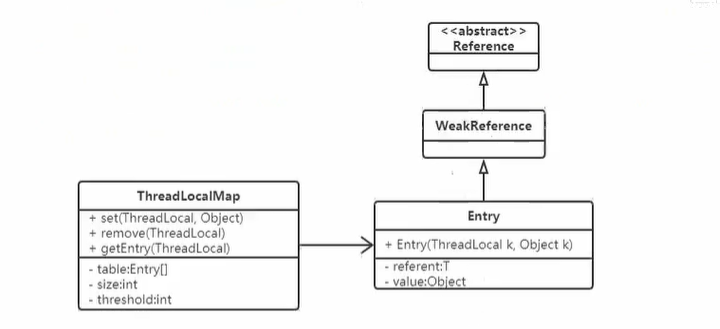
成员变量
/**
* The initial capacity -- MUST be a power of two.
*/
private static final int INITIAL_CAPACITY = 16;
/**
* The table, resized as necessary.
* table.length MUST always be a power of two.
*/
private Entry[] table;
/**
* The number of entries in the table.
*/
private int size = 0;
/**
* The next size value at which to resize.
*/
private int threshold; // Default to 0
/**
* Set the resize threshold to maintain at worst a 2/3 load factor.
*/
private void setThreshold(int len) {
threshold = len * 2 / 3;
}
/**
* Increment i modulo len.
*/
private static int nextIndex(int i, int len) {
return ((i + 1 < len) ? i + 1 : 0);
}
/**
* Decrement i modulo len.
*/
private static int prevIndex(int i, int len) {
return ((i - 1 >= 0) ? i - 1 : len - 1);
}
存储结构-Entry
/**
* The entries in this hash map extend WeakReference, using
* its main ref field as the key (which is always a
* ThreadLocal object). Note that null keys (i.e. entry.get()
* == null) mean that the key is no longer referenced, so the
* entry can be expunged from table. Such entries are referred to
* as "stale entries" in the code that follows.
*/
static class Entry extends WeakReference<ThreadLocal<?>> {
/** The value associated with this ThreadLocal. */
Object value;
Entry(ThreadLocal<?> k, Object v) {
super(k);
value = v;
}
}
Entry中的eky只能是ThreadLocal对象,已经在构造方法中写死了。另外,Entry继承了WeakReferrence,也就是key(ThreadLocal)是弱引用,其目的是将ThreadLocal对象的声明周期和线程声明周期解绑。
构造方法
/**
* Construct a new map initially containing (firstKey, firstValue).
* ThreadLocalMaps are constructed lazily, so we only create
* one when we have at least one entry to put in it.
*/
ThreadLocalMap(ThreadLocal<?> firstKey, Object firstValue) {
table = new Entry[INITIAL_CAPACITY];
int i = firstKey.threadLocalHashCode & (INITIAL_CAPACITY - 1);
table[i] = new Entry(firstKey, firstValue);
size = 1;
setThreshold(INITIAL_CAPACITY);
}
重点 int i = firstKey.threadLocalHashCode & (INITIAL_CAPACITY - 1);
/**
* ThreadLocals rely on per-thread linear-probe hash maps attached
* to each thread (Thread.threadLocals and
* inheritableThreadLocals). The ThreadLocal objects act as keys,
* searched via threadLocalHashCode. This is a custom hash code
* (useful only within ThreadLocalMaps) that eliminates collisions
* in the common case where consecutively constructed ThreadLocals
* are used by the same threads, while remaining well-behaved in
* less common cases.
*/
private final int threadLocalHashCode = nextHashCode();
/**
* Returns the next hash code.
*/
private static int nextHashCode() {
return nextHashCode.getAndAdd(HASH_INCREMENT);
}
/**
* The next hash code to be given out. Updated atomically. Starts at
* zero.
*/
private static AtomicInteger nextHashCode =
new AtomicInteger();
/**
* The difference between successively generated hash codes - turns
* implicit sequential thread-local IDs into near-optimally spread
* multiplicative hash values for power-of-two-sized tables.
*/
private static final int HASH_INCREMENT = 0x61c88647;
关于firstKey.threadLocalHashCode & (INITIAL_CAPACITY - 1);
这里定义了一个AtomicInteger类型,每次获取当前值并加上HASH_INCREMENT,这个值跟斐波那契数列有关,其主要目的就是为了让哈希码能均匀的分布在2的n此房的数组里,也就是Entry[] table中,这样做可以尽量避免hash冲突
关于& (INITIAL_CAPACITY - 1)
计算hash的时候里面采用了hashCode&(size - 1)的算法,这相当于取模运算hashCode % size的一个更搞笑的实现。正式因为这种算法,我们要求size必须是2的整次幂,这也能保证在索引不越界的前提下,使得hash冲突的次数减小。
set方法
/**
* Set the value associated with key.
*
* @param key the thread local object
* @param value the value to be set
*/
private void set(ThreadLocal<?> key, Object value) {
// We don't use a fast path as with get() because it is at
// least as common to use set() to create new entries as
// it is to replace existing ones, in which case, a fast
// path would fail more often than not.
Entry[] tab = table;
int len = tab.length;
int i = key.threadLocalHashCode & (len-1);
for (Entry e = tab[i];
e != null;
e = tab[i = nextIndex(i, len)]) {
ThreadLocal<?> k = e.get();
// 如果存在,覆盖
if (k == key) {
e.value = value;
return;
}
if (k == null) {
replaceStaleEntry(key, value, i);
return;
}
}
tab[i] = new Entry(key, value);
int sz = ++size;
if (!cleanSomeSlots(i, sz) && sz >= threshold)
rehash();
}
/**
* Increment i modulo len.
*/
private static int nextIndex(int i, int len) {
return ((i + 1 < len) ? i + 1 : 0);
}
- 根据key计算出索引i,然后查找位置上的Entry
- 如果entry已经存在并且key等于传入key,直接覆盖
- 如果entry存在,但是key为null,调用replaceStaleEntry来更换这个key为空的entry
- 不断玄幻检测,知道遇到为null的地方,这时候要是还没在循环过程中return,那么久在这个null的位置新建一个Entry并且插入,size+1
- 最后调用cleanSomeSlots,清理key为null的entry,最后返回是否清理了entry,接下来再来判断sz是否>=thredhold达到rehash的条件,达到的话就调用rehash函数执行一次权标的扫描清理
/**
* Replace a stale entry encountered during a set operation
* with an entry for the specified key. The value passed in
* the value parameter is stored in the entry, whether or not
* an entry already exists for the specified key.
*
* As a side effect, this method expunges all stale entries in the
* "run" containing the stale entry. (A run is a sequence of entries
* between two null slots.)
*
* @param key the key
* @param value the value to be associated with key
* @param staleSlot index of the first stale entry encountered while
* searching for key.
*/
private void replaceStaleEntry(ThreadLocal<?> key, Object value,
int staleSlot) {
Entry[] tab = table;
int len = tab.length;
Entry e;
// Back up to check for prior stale entry in current run.
// We clean out whole runs at a time to avoid continual
// incremental rehashing due to garbage collector freeing
// up refs in bunches (i.e., whenever the collector runs).
int slotToExpunge = staleSlot;
for (int i = prevIndex(staleSlot, len);
(e = tab[i]) != null;
i = prevIndex(i, len))
if (e.get() == null)
slotToExpunge = i;
// Find either the key or trailing null slot of run, whichever
// occurs first
for (int i = nextIndex(staleSlot, len);
(e = tab[i]) != null;
i = nextIndex(i, len)) {
ThreadLocal<?> k = e.get();
// If we find key, then we need to swap it
// with the stale entry to maintain hash table order.
// The newly stale slot, or any other stale slot
// encountered above it, can then be sent to expungeStaleEntry
// to remove or rehash all of the other entries in run.
if (k == key) {
e.value = value;
tab[i] = tab[staleSlot];
tab[staleSlot] = e;
// Start expunge at preceding stale entry if it exists
if (slotToExpunge == staleSlot)
slotToExpunge = i;
cleanSomeSlots(expungeStaleEntry(slotToExpunge), len);
return;
}
// If we didn't find stale entry on backward scan, the
// first stale entry seen while scanning for key is the
// first still present in the run.
if (k == null && slotToExpunge == staleSlot)
slotToExpunge = i;
}
// If key not found, put new entry in stale slot
tab[staleSlot].value = null;
tab[staleSlot] = new Entry(key, value);
// If there are any other stale entries in run, expunge them
if (slotToExpunge != staleSlot)
cleanSomeSlots(expungeStaleEntry(slotToExpunge), len);
}
ThreadLocalMap使用线性探测法来解决哈希冲突。
该方法一次探测下一个地址,直到有空的地址后插入,弱整个空间都找不到空余的地址,则产生一处。
弱引用和内存泄漏
在使用ThreadLocal的过程中发现有内存泄漏的情况发生,猜测这个内存泄漏跟Entry中使用了弱引用的key有关系。其实这个理解不对。
内存泄漏的相关概念
- Memory overflow,没有足够的内存提供申请者使用
- Memory leak,指程序中已动态分配的堆内存由于某种原因程序未释放或无法释放,造成系统内存的额浪费,导致运行速度减慢甚至系统崩溃等严重后果。内存泄漏的堆积终将导致内存溢出。
弱引用的相关概念
强引用(Strong Reference),就是我常见的普通对象引用,只要还有强引用指向一个对象,就证明对象还活着,垃圾回收旧不会回收这种对象。
弱引用(Weak Reference),垃圾回收器一旦发现了值具有弱引用的对象,不管当前内存空间足够与否,都会回收它的内存。
如果key使用强引用
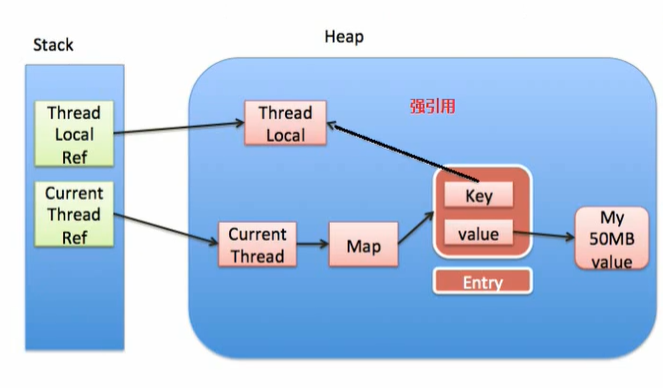
- 假设在业务代码中使用完ThreadLocal,threadLocal Ref被回收了。
- 但是因为threadLocalMap的Entry强引用了threadLocal,造成了threadLocal无法被回收。
- 在没有手动删除这个Entry以及CuccrentThread依然运行的前提下,始终有强引用链threadRef->currentThread->threadLocalMap->entry,导致Entry内存泄漏、
也就是说,ThreadLocalMap中的key使用了强引用,是无法完全避免内存泄漏的。
如果Key使用弱引用
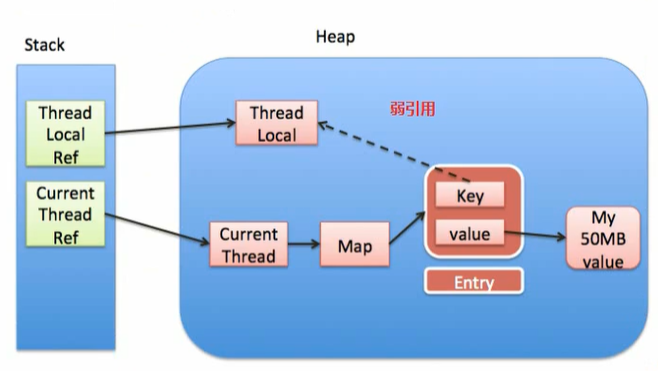
- 还是假设在业务代码中使用完ThreadLocal,threadLocal Ref被回收了
- 由于THreadLocalMap值持有THreadLocal的弱引用,没没有任何强引用指向threadLocal实例,所以threadLocal就可以顺利地被gc回收,此时Entry中的key = null。
- 但是在没有手动删除这个Entry以及CurrentThread依然运行的前提下,在有强引用链 threadRef -> currentThread-> threadLocalMap -> entry -> value, value不会被回收,而这块value永远不会被访问到了,导致value 内存泄漏
也就是说,ThreadLocalMap中的key使用了弱引用,也有可能内存泄漏。
需要能回答的问题
Java中的引用类型有哪几种?
每种引用类型的特点是什么?
每种引用类型的应用场景是什么? ThreadLocal你了解吗
ThreadLocal应用在什么地方? Spring事务方面应用到了
ThreadLocal会产生内存泄漏你了解吗?